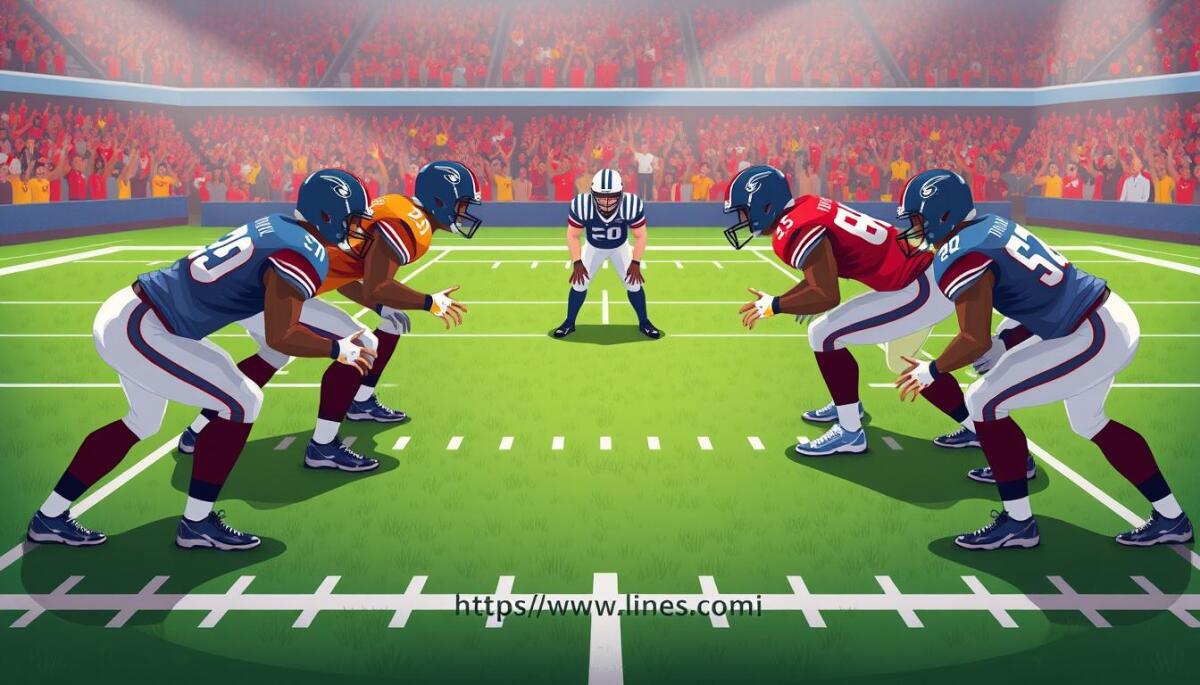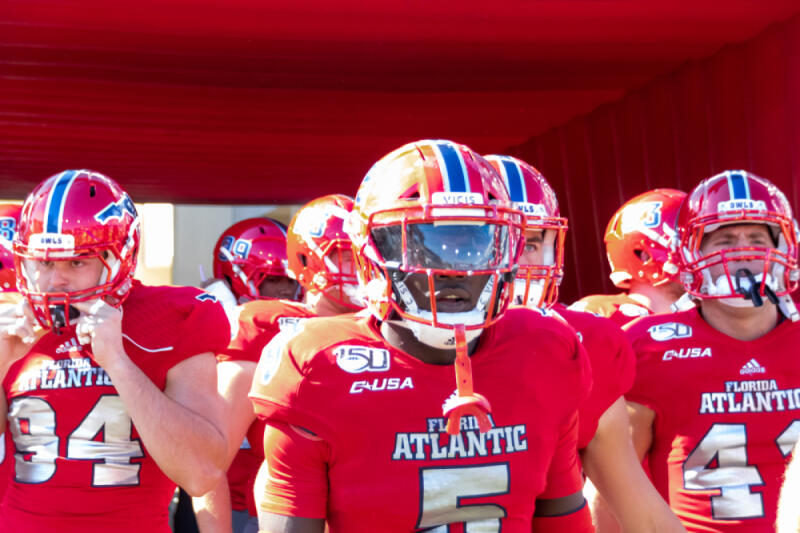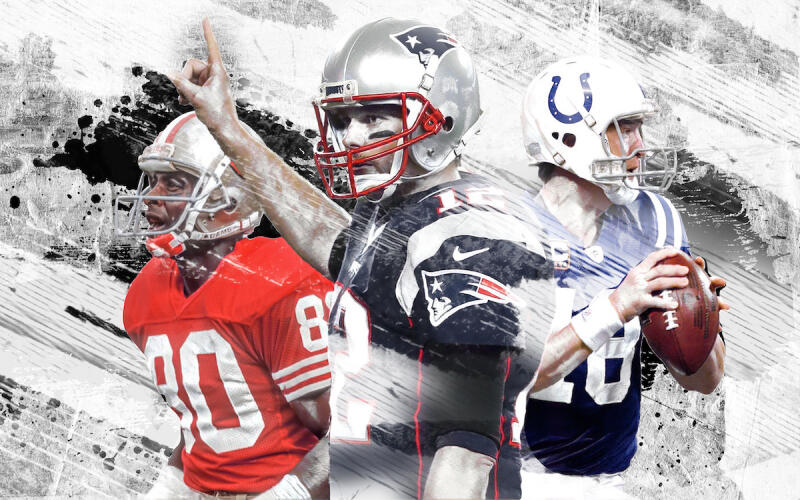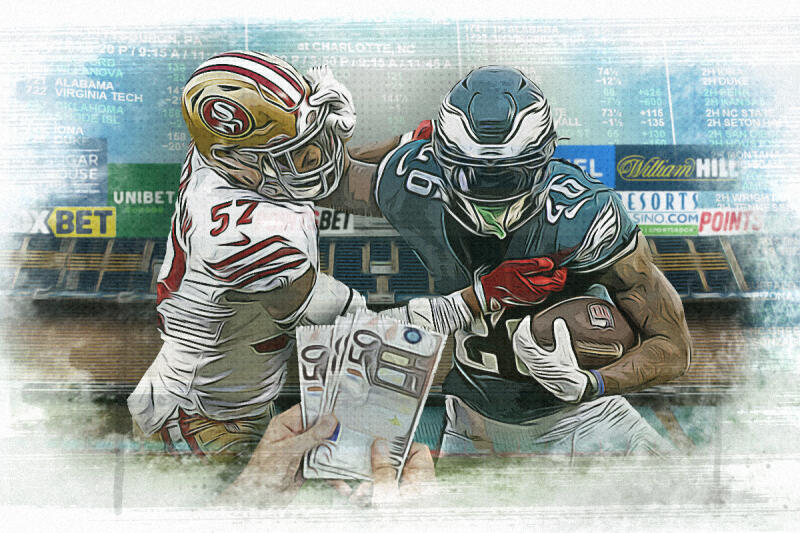American Football Positions Explained: The Ultimate Guide
American football positions are all about strategy and athletic skill. Players like the quarterback make important throws. The offensive line defends fiercely. Every football position plays a key role in the game’s outcome. This guide will dive deep into each position and their responsibilities from the line of scrimmage.
Understanding football positions is crucial. Every role in the sport is carefully planned and vital for the game's overall strategy.
Key Takeaways
- A football team puts 11 players on the field – for both offense and defense – each with their own duties. There are 22 players total on the field.
- The quarterback is crucial to the offense, directing plays all alone on the field.
- Offensive formations usually have two guards and tackles, plus a key center.
- Wide receivers and tight ends enhance the passing game, evolving in modern offenses.
- Defensive and offensive teams have specialized roles, showing the strategic depth of football positions.
Introduction to Football Positions

In American football, understanding football positions explained offers deeper insight for fans, players, and coaches. The field showcases a variety of positions in football. Each has distinct roles and responsibilities that boost the team's performance. Let's learn about the 11 positions in football and their duties during a game.
The offense is key, with players working to advance the ball and score points. They must work together flawlessly for successful plays. The offensive line is crucial, with five main roles: left tackle, left guard, center, right guard, and right tackle. The center is vital, as every play starts with him snapping the ball to the quarterback.
Recommended Read: NFL Offense Rankings 2024
The defense's setup can vary but often includes three to four defensive linemen. These players face the offense across the scrimmage line. They consist of defensive tackles (DTs), including a nose tackle if there's only one DT, and defensive ends (DEs). Their goals are to stop the opposing offense, tackle runners, and pressure the quarterback.
Recommended Read: Best NFL Defenses 2024
Understanding roles beyond the basic linemen shows how football strategies are built. Running backs and fullbacks work to break through defense for yardage. Wide receivers and tight ends use speed and agility to catch passes. The tight end has a double role, combining a lineman's blocking with a receiver's catching ability.
This setup not only highlights individual roles but also shows the strategy in football. Whether moving the ball or defending, every position is key to the game's goals.
Get the latest and best NFL betting odds today!
How Many Football Players Are on the Field?
In the world of football, each team has exactly 11 players. This is set by the game's rules. This setup allows teams to make detailed plans and use players' strengths.
Knowing the number of players and their roles is key to understanding football. The eleven starters are divided into offense, defense, and special teams. Special teams come on for things like kickoffs.
| Category | Number of Players | Common Roles |
| Offensive Team | 6 Players | Quarterback, Running Back, Tight End, Wide Receivers |
| Offensive Line | 5 Players | Center, Offensive Guards, Offensive Tackles |
| Defensive Team | Varies | Central Defenders, Full Backs, Defensive Midfielders |
| Special Teams | Specific Plays | Kicker, Long Snapper, Punt Returner |
Football is more than just assigning players to positions. It's about forming a strategy to win. Each player's skills and speed are critical. This makes American football a mix of strategy and excitement. Get our list of the best NFL players of all time here.
Overview of the 11 Positions in Football
Knowing football positions in American football is essential for understanding the game. It helps tell apart the offensive and defensive roles. The NFL uses these positions to make the most of each player’s skills. This boosts the team's dynamics and success on the field. Let’s look at the 11 NFL positions and what they do.
The offense has players who work together to move the ball downfield. Their goal is to score by reaching the opponent’s end zone. There are four main position types: Backs, Receivers, Offensive Linemen, and the all-important Quarterback.
- Quarterback (QB): The leader of the offense, the quarterback makes play calls and is vital for passing and running the ball.
- Running Backs (RB): Found near the quarterback, running backs help with rushing and protecting against opponent's plays.
- Wide Receivers (WR): They can be as many as five in some plays. Their job is to catch the ball and dash through the opponent’s line.
- Offensive Linemen: This group includes the center, guards, and tackles. They guard the quarterback and create paths for running the ball.
Defensive roles focus on preventing the offensive team from scoring. They have varied roles that challenge plays, watch receivers, and protect the end zone.
- Defensive Linemen: This includes tackles and ends who go against the offensive line to disrupt plays and target the quarterback.
- Linebackers: Located behind the defensive line, they block both running and passing plays. They chase the ball carrier and cover the receivers.
- Defensive Backs: Made up of cornerbacks and safeties, they are key in defending against passes and making important tackles.
Every NFL position has a specific role. This makes the game more strategic and exciting. The complex role division draws big audiences to NFL games, sometimes reaching over 100 million watchers.

Check out every NFL Prediction for the entire season!
Offensive Positions in Football
Football is a game packed with strategy, thanks in part to the variety of offensive football positions. We'll look at the roles on offense, especially how each one helps the team score. This includes players on the offensive line.
Quarterback (QB)
The quarterback runs the show on the field. They call plays and make quick decisions that can win the game. Known as the team's leader, the QB's job is to distribute the ball effectively.
Running Back (RB)
The running back is key to the team's rushing game. They need to be quick and tough, darting through tight spaces and blocking when needed. They usually line up behind the quarterback and run between the offensive line.
Fullback (FB)
Though less common today, the fullback has a solid role in run-heavy plays. Positioned near the line, they can block or carry the ball for short gains, making the offense more dynamic.
Wide Receiver (WR)
Wide receivers are the fast players on the team. They run routes to get past defenders and catch the ball. Great speed, good hands, and precise route-running are musts for this position.
Types of Wide Receivers
- Split end
A split end is an attacking player who is positioned farthest away from the core of the line. They are one of the seven players on the scrimmage line, and because they are at the edge of the line, they are eligible for receiving passes.
- Flanker
Because it was developed so long ago, the flanker role can sometimes be difficult to explain. Flankers, who spread out far like a split end, are not typically the primary focus of an offense and are generally entrusted with being the second alternative in passing plays.
- Slot receivers
The slot receiver earned its moniker from where he usually lines on the playing field. And because he works better outside the offensive line, he is frequently far more nimble and versatile in what he is supposed to do.
Tight End (TE)
Tight ends mix the roles of a lineman and a receiver. They either strengthen the offensive line or catch passes, depending on the play call.
Offensive Line Positions
The offensive line protects the quarterback and opens paths for runners. There are five offensive lineman: center, two guards, and two tackles. The left tackle guards the QB's blind side, while the guards help in blocking efforts.
| Position | Role | Key Responsibility |
| Center | Snaps the ball, blocks | Central anchor of the line |
| Left Guard | Blocking | Assists in double-team blocking |
| Right Guard | Blocking | Supports right tackle in blocking schemes |
| Left Tackle | Blocking | Protects quarterback’s blind side |
| Right Tackle | Blocking | Integral in run blocking |
Check out the highest scoring NFL games in history.
Defensive Positions in Football
Knowing defensive football positions helps you enjoy the game more. This section explains the key roles in defense. It shows how they work together to stop the other team.
Defensive Line Positions
The defensive line is the team's first defense. They try to block runs and pressure the quarterback. Key players are the defensive ends and tackles. They need to be strong, fast, and quick.
Linebacker Positions on Defense
Linebackers connect the middle of the defensive side of the ball. They stand behind the defensive line. They stop runs and defend against passes. They must be fast, strong, and smart.
Defensive Backs (DB)
Defensive backs stop long passes and catches by the offense. They include safeties and cornerbacks. They need great speed and judgment.
Types of NFL Defensive Backs
- Strong safety
In today's American football, strong safety functions almost as something of an extra linebacker. A strong safety will begin the game on the strong side of the game, based on how the offense aligns.
If there is no tight end on the pitch, the quarterback's dominant hand determines the strong side. In these cases, for example, if the QB is right-handed, the strong side is the right flank of the pitch.
Because strong safeties are primarily concerned with preventing the run, they will frequently play near the scrimmage line. He may fall in line several yards in the defensive backfield and must be quick enough to block the throw.
- Free safety
Free safeties are more comparable to cornerbacks in height, abilities, and attributes in comparison to linebackers. He will begin the play by lining up on the opposite side of the strong safety.
If any of the football offensive positions gets beyond the free safety, that guy is set for the sprints toward the goal line. As a result, free safeties are typically more concerned with pass defense than with run defense.
When confronted with a run, the strong safety might creep toward the line of scrimmage and become even more active in attempting to tackle the ball carrier. Meanwhile, a free safety must stand back and analyze the action.
- Cornerback
A cornerback is a football defensive position that is primarily responsible for preventing the other team from making forward passes. Corners are unlikely to be a key part of any run defense, but they must be prepared to step up when needed, particularly if a ball carrier is approaching.
They will have to beat the blockers on running plays because they are lined up against the wide receiver. When opponents rush, they anticipate their wide receivers from containing the cornerbacks.
Because of the agility of wide receivers, speed is one of the most important factors in being a cornerback. As long as a corner has adequate speed, he or she should be able to catch up with receivers.
- Nickelback
The nickelback used to be a defensive player who saw action only on decisive passing downs. The role gets its nickname from the fact that there can be five secondary players on the pitch in certain scenarios.
With teams electing to throw more and extend the ground these days, many defenses have responded by deploying a nickelback on virtually all turnovers. This has elevated the nickelback from a hardly ever used substitute to a starting player.
Nickelbacks are specifically taught to master the technique of shielding receivers. They typically cover slot wide receivers, who are more inclined to run direct routes through the center of the field and to the wings.
Special Teams Positions
The crucial moments of a football game often hinge on the special teams unit. This group is key during kickoffs, field goals, and punts. They are made up of roles designed for very important situations. These players help a lot in changing the game's direction and in scoring.
Kicker (K)
The kicker plays a big role in scoring through field goals and extra points after touchdowns. Tense moments often see them in action, with their kicks sometimes deciding the game. Their job is very important because it helps the team win.
Punter (P)
The punter comes in when the offense can't advance, aiming to win back territory. It's vital to punt the ball away from defenders safely. Punt protectors are crucial for giving the punter time to punt without being blocked. They help change where the game is played on the field.
Long Snapper (LS)
The long snapper's accuracy is critical, being over 99% accurate. This ensures that kickers and punters get the ball just right, for either a long punt or a key field goal. Their skill is very important for the team's success.
Kick Returner (KR) & Punt Returner (PR)
Kick and punt returners are known for their quickness and moves, often also playing as wide receivers or running backs. They are key in getting through the other team's special teams. Getting an average of 25 to 30 yards per return, they help the team get into a better position to score.
Special teams football is more than just one part of the game. It includes different groups, each with a special skill for different game moments, like the kickoff, punting, and field goal units. How well each group does can really change the game, showing how deep strategy goes in special teams football.
| Position | Impact Statistic | Description |
| Long Snapper | 99% accuracy rate | Delivers flawless snaps under pressure. |
| Kick/Punt Returner | 25-30 yards per return | Averages significant yardage, enhancing field position. |
| Gunners (Punt Coverage) | Average speed of 4.5 seconds | Quickly covers the field to tackle returners. |
| Punt Protector | 2-3 seconds protection time | Shields the punter from defenders effectively. |
Understanding Offensive vs. Defensive Roles in American Football
Understanding the difference between offense and defense is key to enjoying American football. Learning about football positions helps us see how the game works. This includes knowing about offensive line positions and defensive line positions.
Offensive roles aim to move the ball forward to score. Quarterbacks, running backs, and offensive linemen play these roles. Quarterbacks manage the ball, while running backs are known for their speed. Offensive linemen protect the quarterback and clear paths.
Defensive roles aim to stop the offense. They include defensive linemen, linebackers, and defensive backs. Linebackers and linemen stop runs and pressure the quarterback. Defensive backs prevent successful passes.

To understand these roles better, look at their detailed responsibilities:
| Position | Offensive Roles | Defensive Roles |
| Quarterback | Orchestrates offensive plays, decides on passing or handing off the ball | N/A |
| Running Back | Carries the ball, catches passes, blocks defenders | N/A |
| Offensive Linemen | Blocks defenders to protect the quarterback and create paths for runners | N/A |
| Defensive Tackles/Ends | N/A | Works to stop the run and pressure the quarterback |
| Linebackers | N/A | Handles main tackling responsibilities, stops runs, and covers receivers |
| Cornerbacks | N/A | Covers wide receivers to prevent pass successes |
Understanding offensive line positions and defensive line positions makes us value the game more. It shows the strategy in American football. The excitement comes from seeing offense and defense clash on the field.
Common Football Lineups and Formations (American Football)
The beauty of American football lies in its various lineups and formations, which are essential for understanding the game's tactics. These formations reveal how teams plan their strategies during different phases of a game.
- In the early days of American football, strategies were straightforward, with formations like the "Single Wing" dominating play in the early 1900s. Over time, formations evolved to adapt to the increasing complexity of the game, balancing offensive firepower with defensive strength.
- The "I-Formation," for example, became popular in the 1970s and 1980s, providing a balanced approach to both running and passing. It features a fullback and tailback aligned directly behind the quarterback, allowing flexibility in either running or passing plays.
- The "4-3 Defense" is one of the most widely used defensive formations today. It consists of four defensive linemen and three linebackers, creating a strong front against the run while providing adequate pass coverage. This formation is effective against offenses that rely heavily on running plays.
- The "Spread Offense," often seen in modern American football, emphasizes passing and spreading the defense across the field. With four or five wide receivers, this formation forces the defense to cover more ground, making it easier for the quarterback to find open targets.
- The "3-4 Defense," featuring three defensive linemen and four linebackers, offers flexibility and adaptability. It allows teams to disguise blitzes and adapt to various offensive strategies, making it harder for the offense to predict defensive movements.
- The "Shotgun Formation" is commonly used for passing plays. The quarterback lines up several yards behind the center, allowing more time to read the defense and make accurate throws. This formation is frequently seen in situations where a team needs to gain substantial yardage quickly.
- The "Wildcat Formation," often utilized for its unpredictability, involves a direct snap to a running back instead of the quarterback. This formation gives offenses a chance to confuse defenses and execute trick plays.
Positions in these formations are dynamic, with players often shifting roles as plays develop. For example, a running back may be used as an additional blocker, or a wide receiver might act as a decoy to create space for another player. Every role, from quarterback to defensive end, is vital, and specialized positions like nickelbacks and slot receivers add to the complexity.
Coaches choose formations based on their team's strengths and their opponent’s weaknesses. Adjusting formations is crucial to adapting to different game situations, whether focusing on a strong running attack, a balanced offense, or a heavy passing game.
Here’s a look at how some of these formations function:
| Formation | Defensive Strength | Offensive Flexibility |
| 4-3 Defense | High | Moderate |
| Spread Offense | Spread Offense | High |
| I-Formation | Medium | Balanced |
| 3-4 Defense | Strong | Adaptable |
| Shotgun Formation | Medium | Very High |
Each formation carries its unique tactical advantages, designed to maximize player skills and teamwork. By exploiting gaps in the defense or creating strong coverage, the right formation can change the momentum of a game, leading to success on the field.
Want to bet on NFL football? Learn how today!
Mastering Football Positions
Football is more than just a game. It's a blend of strategy, physical strength, and mental sharpness. To excel, players must understand their roles deeply. This includes rigorous training and a strategic mind. Each player has a special skill that helps the team succeed.
Defensive roles are tough. Players like defensive tackles face many hard impacts. Linebackers deal with up to 80 collisions in a game. This shows how brave and strong they are.
On the other side, offensive roles are highlighted by the ability to make big plays happen.Running backs and wide receivers are heralded for their speed skillset, while offensive linemen and tight ends need to be able to block and move – and sometimes catch.
Football Positions FAQs
What are the main football positions?
Football positions are split into three main groups. Offensive positions include the quarterback (QB), running backs (RB and FB), wide receivers (WR), and more. Defensive positions have linemen (DT and DE), linebackers (LB), and others. Special Teams cover roles like the kicker (K) and punter (P).
How many football players are on the field at any given time?
Each team has 11 players on the field during a game. This makes a total of 22 players actively playing.
Can you explain the role of a quarterback?
The quarterback leads the offense and line up behind the center. They call plays, handle the ball, and make key decisions. It's their job to run the team's offense smoothly.
What is the function of the offensive line?
Five players make up the offensive line. They work to block defensive players, protect the quarterback, and open paths during running plays. Everything starts behind the offensive line.
What do defensive backs do?
The Defensive back is called a DB, with some defenses having five defensive backs stop the pass. They cover receivers, block long throws, and tackle in the field. This includes free safeties and strong safeties plus the cornerbacks.
What roles do special teams play?
Special teams focus on kicking plays. Their roles include kicker, punter, and returners. These players handle key game moments. Returners receive the ball during the kickoff.
How do understanding football positions and formations enhance viewing the game?
Knowing about positions and formations makes watching football more fun. It helps fans see the strategy and guess plays. Combine this knowledge with understanding the rules of American football and you'll be ready to enjoy every game in the NFL schedule.
What differentiates a cornerback from a safety?
Cornerbacks are part of the defensive backs. They cover receivers and line up outside. Safeties play deep, help against the pass, and support the run defense.
Are all football positions suited for any player?
Not really. Each position needs specific skills and physical traits. Players find positions that match their abilities for the team's benefit. Each player has different positions and responsibilities across the field.
What is the key to mastering a football position?
To master a position, you need athletic skill, strategic game knowledge, and tough training. Also, you must perform your role well in games.
Our editorial content strives to be highly informative and educational to our audience, especially for visitors who are new or relatively new to analyzing and predicting sporting event results. All of our content is created by informed writers with backgrounds in their subject area and reviewed for omissions or mistakes.
Our editorial team is run by individuals with many years of experience in digital publishing, editorial, and content production. Our editorial content is always marked clearly in any instances where it may be sponsored by a third party, though it is still reviewed by our staff to ensure it remains consistent with our company mission.
- Popular
- Latest





